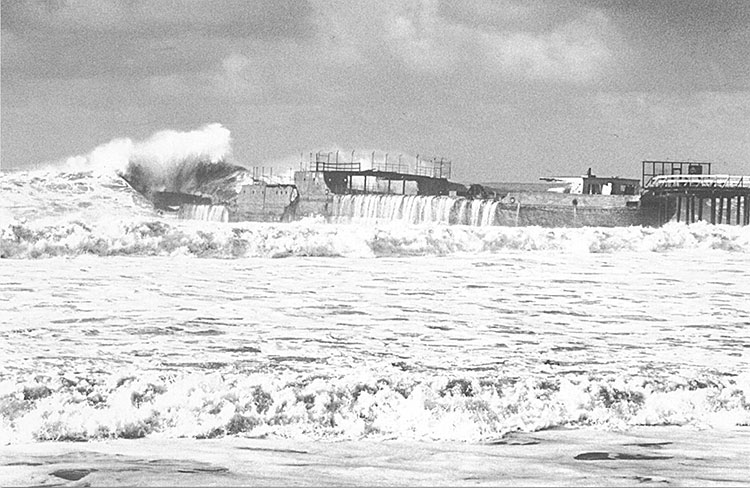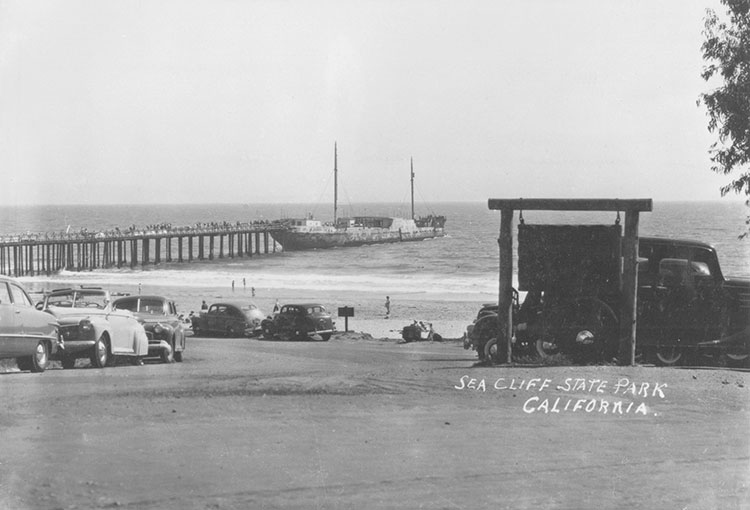 In the two previous parts of this story, I told you how and why the S.S. Palo Alto (The Cement Ship) was built and how she ended up in Aptos. Launched in May 1919 and arriving in Aptos in January 1930, the Cement Ship was part of the Seacliff Amusement Corporation’s plan of developing Seacliff into a tourist attraction. The “entertainment ship” was equipped with activities such as dining, dancing, swimming, fishing, and gaming.
In the two previous parts of this story, I told you how and why the S.S. Palo Alto (The Cement Ship) was built and how she ended up in Aptos. Launched in May 1919 and arriving in Aptos in January 1930, the Cement Ship was part of the Seacliff Amusement Corporation’s plan of developing Seacliff into a tourist attraction. The “entertainment ship” was equipped with activities such as dining, dancing, swimming, fishing, and gaming.
By June 1930 she had settled into her final resting place, the pier was built out, and she was ready to open her doors to the public. Even in the midst of the Great Depression, the ship’s opening weekend was a smashing success! An estimated 3,000 people boarded the Palo Alto that weekend. Sadly, this success would be short lived.
Business slowed over the next several months, partially due to tourist season coming to an end but also because the financial collapse of the national economy was beginning to take a toll locally. During the winter of 1930-31, the ship was closed more often than not.
The ship’s dancehall, The Rainbow Ballroom, had its grand reopening on Memorial Day 1931, and would remain open on Saturday nights. Once again, however, this stint of success would be short lived.
 The winter of 1932 was quite stormy and did significant damage. The road leading to the beach was completely washed out. The powerful surf also did its fair share of damage to the ship. A crack in the hull amidships had formed and the Palo Alto was closed for business. The road was eventually repaired. The ship was not. On April 26, 1932, the Palo Alto was boarded up. It was the beginning of the end.
The winter of 1932 was quite stormy and did significant damage. The road leading to the beach was completely washed out. The powerful surf also did its fair share of damage to the ship. A crack in the hull amidships had formed and the Palo Alto was closed for business. The road was eventually repaired. The ship was not. On April 26, 1932, the Palo Alto was boarded up. It was the beginning of the end.
Shortly thereafter, the Seacliff Amusement Corporation defaulted on it’s loan with the Calavada Investment Company, who in turn hired the Santa Cruz Land Title Company as trustee to retrieve whatever they could from their original investment. The title company sold itself the land for a bargain price of $10,000 and sold the ship back to the Calavada Investment Company for $10. The beach was offered to the State of California as part of a gift-sale transaction, which established Seacliff Beach State Park.
Two years later, in 1934, Harry Lord purchased the right to dismantle the abandoned vessel and to sell everything salvageable.
Everything from furniture, kitchen equipment, bronze and brass fittings, to the lumber in the decks and outer wooden walls were sold to this highest bidder. He did keep some of the items for himself, including a chair from the dining area, which will be on display during the Aptos History Museum’s Centennial Celebration of the Cement Ship on May 18th 2019, thanks to Harry’s great grand nieces.
Arthur Wikkerink and Walter Pilgrim had purchased the ship from the Calavada Investment Company and on February 26, 1936, they sold it to the California Division of Parks for one dollar. That’s not a typo. You read that correctly. The 7,500-ton concrete tanker that cost $1.5 million to build just 17 years earlier was sold to the Division of Parks for just one dollar.
In 1948, the State Lands Commission officially transferred the tidelands and bottom around the ship to the Park Service and once again the ship found new life as Seacliff State Beach’s fishing pier.
The crack in the hull was enlarged during the storms of 1939 but wasn’t deemed unsafe until 1958 when the foredeck was officially closed. The following year, the 76-foot masts were removed as they too were deemed to be rotten and hazardous.
During the 1950s, Ralph Creffield’s bait and tackle shop occupied the stern cabin. He also rented rowboats, which were stored on deck and lowered over the port side with a small crane. Creffield also had a hamburger stand in a trailer installed around 1945 towards the entrance to the pier. It was replaced with a larger wooden hamburger stand in the early 1960s and in 1983 was moved off the pier and directly across the road where it survives today. It was most recently home to Marianne’s Ice Cream.
Several storms have continued to damage the old ship, including 1963 when the hull was broken off and the bow settled several feet into the sand. In January 1978, heavy storms increased the break in the hull amidships. More heavy storms in January of 1980 caused the Parks System to announce the ship would be closed indefinitely.
Local fishermen (and fisherwoman), Harry Haney, Ed Nelson, and Rose Costa, decided to save the ship. With community volunteers and monetary donations, they were able to reopen the ship in July 1983. The ship remained open until October 27th, 2001, when it was announced she would be closed again. This time it was for good.
The most recent damage occurred in January 2017, when a storm managed to break off a section of the ship’s stern about 50 feet long from the main hull and flipped on its side.
The S.S. Palo Alto went from an oil tanker, to an entertainment ship, to a fishing pier, and will now live out the rest of her days as an artificial reef and a symbol of Aptos History.
•••
Please join me at the Rio Sands Hotel on May 18th from 2-3:30 p.m. for a very special presentation honoring the centennial of the S.S. Palo Alto. RSVP required: 831-688-1467.

